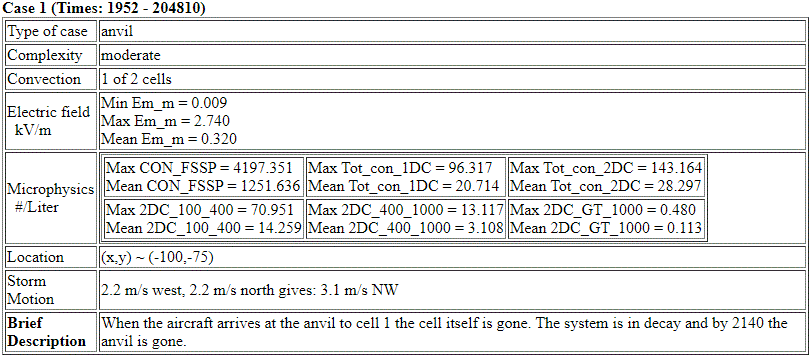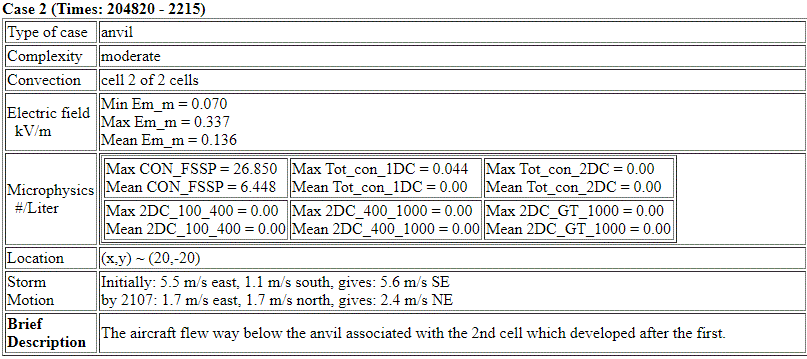Synthesis for June 25, 2001


There is no lightning data for this day.
The storm comes in at (-150,-150) the very edge of the grid at about 1750. It is not clear if there were 2 cells or if a single cell split. For the sake of this discussion I will treat it as 2 separate cells. By 1833 there are definately 2 cells and cell 1 (the northwestern most) shows a good anvil at the upper levels. By 1910 the 2 cells have increased the distance between them and cell 2 is either developing its own anvil or it is taking some of cell 1's anvil with it.
Due the to proximity to the grid edge the velocities are tenuous. In the earlier stages the two cells seem to repel each other, then after cell 1 dissipates cell 2 has a different velocity vector. A difficulty in determining the velocity of cell 2 (once cell 1 in gone) is that the storm appears to propogate by 'jumping' rather than a smooth motion. In other words, a core will move slightly then dissipate, while a new core grows just ahead of the first. The motion entered above in Storm Motion is the motion of a single core. If you look at the propagation that would be:
3.3 m/s east, 3.3 m/s north, gives: 4.7 m/s NE
Summary for June 25, 2001
Investigator: (Eric Defer)
Preliminary Results
Description: One single storm has been sampled that day. A storm located over Tampa blew a huge anvil over Central Florida (>100 km, GOES animation [8 Mb]). Four passes were performed in the anvil (track). The first pass started about 90 km away and 30 min after the last CG flash (all CGs were with negative polarity). No LDAR data (total lightning activity) are available for that day. The electric field did not exceed 3 kV/m for the entire flight. The first pass shows an increase of the electric field when flying nearby a 15dBZ region (200550 UT). The same phenomena occured during the second pass (north-east direction at about 2014 UT). The electric field was weaker for the two other passes (overview).
For the entire flight, the time series of the concentration show:
- FSSP concentration for the entire flight between 100 and 2000 particles per liter.
- Total 2DC concentration between 1 and 150 paticles / liter.
- Concentration of particles > 1 mm is less than 1 particle/liter for the entire flight.
- The south-west edge of the cloud has non monotoneous variation as observed during the periods 2006-2010 , 2011-2014, 2032-2033 and 2037-2038. FSSP and 2DC show the same trends in the concentration for different categories of particle sizes.
- No large particles measured at the south-west edge of the anvil.
- Where E field maximum (3 kV/m), no large or a very few large particles measured by HVPS and 2DC.
Summary

Instruments

HTML page with regrouped plots: 25 June 2001

Detailed analysis of the measurements:
volume scan @ 194909 UT
MER plot
- No particle observations because out of cloud.
- UND-Citation was heading to the storm after notification
- A self calibration of the mills was carried out during that period.
volume scan @ 195146 UT
MER plot
- The aircraft was arriving in the area of the anvil (see the track of the aircraft as well the 74C and nexrad plots).
- First FSSP sensed small particles the cloud, then 2DC reported particles
- MEz (from M-matrix) and KEz (from K-matrix) were similar.
volume scan @ 195423 UT
MER plot
- Particle concentrations show that the aircraft was in cloud during the volume scan. Large particles were measured. Concentrations increased as a function of time as well as the reflectivity at the flight level.
- For most of the scan period, the aircraft was flying in cloud region with reflectivity between 0 and 10 dBZ (temperature close to -30 deg. C).
- MEz and KEz show positive values but very low, with KEz > MEz.
volume scan @ 195660 UT (which should be 195700)
MER plot
- The Citation was still in cloud according to the PMS probes and the reflectivity curtain.
- Large particles measured.
- Reflectivity at flight level was varying between 10 and 15 dBZ.
- Reflectivity at flight level and concentration of particles > 1mm show a similar trend in their time evolution (decrease then increase).
- MEz and KEz show an increasing difference, while MEz goes to 0 and KEz goes to 700 V/m at the end of the volume scan
volume scan @ 195938 UT
MER plot
- The citation still in cloud.
- Reflectivity at the flight level was varying roughly between 10 and 20 dBZ.
- The reflectivity curtain shows the strongest reflectivity was below the Citation.
- MEz and KEz are showing a similar trend (decrease of the E field) but with an offset between of about 700 V/m
volume scan @ 200216 UT
MER plot
- Large particle concentration dropped compared to the one on the previous volume scan. Slight decrease of the FSSP concentration too.
- Reflectivity at the flight level mostly > 10 dBZ.
- Relectivity curtain show most the area with strong reflectivity were below the aircraft.
- Both EZ show an increase but still with a offset of few hundreds of V/m.
volume scan @ 200453 UT
MER plot
- Mostly no large particle during this part.
- Reflectivity along the track mostly between 10 and 15 dBZ.
- Again most of the strong reflectivity along the curtain are below the aircraft.
- the Ez is relatively constant during the first 30 s of the part (with still an offset) then it increased then decreased. Observe that the slopes of MEz and KEz changed when the aircraft was lightning above the 20-25 dBZ area. Observe also that after 200640, MEz and KEz are retrieved with different sign. KEz and MEz reached their maximum of about 3 kV/m at differnt times, probably due to offsets.
I created horizontal cross section associated with the present volume scan at 6, 7, 8 and 9 km msl.
The track is plotted for the period 200240-200840 (6 min period; the beginning of the track is indicated by the square). By looking the 6 km section, the period with an increase EZ (including the previous and present scans) corresponds to the period when Citation was flying 2km above 15 dBZ region. At 7km the same observation can be made except the cloud was composed of pocket of 15dBZ. At 8km altitude, roughly the altitude of the aircraft, the Citation was flying in 10-15 dBZ region. Note that between 200340 and 200700 UT the citation was at the edge of a 15-20 dBZ region. [We need to look the Ey]. At 9km altitude, the aircraft seems to be outside cloud, but I don’t think it is true. The scan strategy and the interpolation of the radar data can explain the absence of radar reconstruction and the different reconstructed rings.
volume scan @ 200731 UT
MER plot
- particles concentrations are dropping. The citation was at the South-West edge of the anvil and started to do a turn at about 201010 UT.
- reflectivity at the flight level is also dropping when the aricraft is heading to the edge of the anvil.
- Both Ez show an negative variation, but KEz changed sign before MEz (40s before) but the trends are the same for the two vertical components of E. There is a 15-20 dBZ region below 7km altitude which may explain the variation of Ez. Note that at the altitude of the aircraft no more than 15dBZ was observed.
volume scan @ 201009 UT
MER plot
- PMS probes do not agree with reflectivity at the flight level [must check the PMS data]. It may also comes from the reflectivity interpolation.
- Both Ez seem consistent but still with an offset. At about 201055 the citation was flying in the area where Ez was relatively high in the previous volume scan. The magnitude of Ez at that time is close to zero, while the horizontal cross section at 5km shows the weaker reflectivity in the same area (compare to the previous scan).
volume scan @ 201246 UT
MER plot
- Large particles reappear during the second part of the scan period in a location consistent with the one at 200453 where large particles were measured.
- Reflectivity at flight level between 5 and 15 dBZ.
- Largest reflectivity below the aircraft.
- Ez increased when the citation was flying close to an area where reflectivity above 15 dBZ was sensed at 6km and 8km.
KEz is greater than MEz before reaching a maximum, then the opposite is observed later. KEz changed sign before MEz (delay of about 6-7s). Maximum Ez about 3 kV/m. At the end of the scan period, there is a difference of about 700 V/m between the retrievals of Ez.
volume scan @ 201524 UT
MER plot
- Large particles observed only at the end of the scan period. Relatively less small particles.
- Reflectivity at flight level between 8 and 12 dBZ.
- Relative homogeneous reflectivity below the aircraft on 2km depth.
- Ez returned to lower values (compared to the previous scan). MEz changed sign at about 201620 while KEz stayed positive and increased slightly during the second part of the scan period.
volume scan @ 201801 UT
MER plot
- Large particles were sensed during the entire scan period. All the concentrations dropped during the study period.
- Reflectivity at flight level (7.5 km msl) between 5 and 12 dBZ.
- Reflectivity along the curtain less than 12dBZ.
- MEz and KEz have opposite signs, and in norm, KEz is about 4 time greater than MEz.
volume scan @ 202038 UT
MER plot
- Citation was making a loop.
- In cloud according to the PMS probes as well as the horizontal cross section at the flight level.
- Reflectivity at the flight level between 5 and 12 dBZ.
- Ez retrievals are opposite in sign and with the same scale factor of about 3.
volume scan @ 202316 UT
MER plot
- All particle categories observed during the scan period.
- Reflectivity at the flight level between 5 and 10 dBZ.
- Reflectivity along the curtain less than 10 dBZ.
- Ez still opposite according to the two matrices. Note that after 202420, both Ez signals look the same except that there is an offset between the two curves, but the variations are the same.
volume scan @ 202553 UT
MER plot
- Large particles disappeared after the half part of the scan period.
- Reflectivity at flight level ranged from 5 to 10 dBZ.
- Ez retrievals still opposite in sign. Less difference between the retrieval at the end of the sacn period.
volume scan @ 202830 UT
MER plot
- Mostly no large particles
- Reflectivity at flight level between 0 and 5 dBZ.
- Gap between Ez retrievals smaller in the beginning of the scan period than at the end.
volume scan @ 203108 UT
MER plot
- Mostly no large particles. Concentrations dropped ate the end of the scan period because outside cloud. Outside cloud at
- Altitude is dropping too, now at 6.5 km.
- Citation started turning at about 203350 UT.
- Variation of Ez different than before with a lot of sudden variations. At 203300, roughly the time when the Citation was out of reflectivity. KEz changed sign and came back positive in 10s. Again, both signals are similar except that MEz is negative and there is scale factor in the variations of Ez. It is like there is an offset plus a scale factor between the two retrievals.
volume scan @ 203345 UT
MER plot
- Citation was doing a loop.
- Particles sensed but no echo radar probably due to scan strategy and reconstruction of gridded data.
- Ez retrievals has opposite signs and a very low (<100 V/m).
volume scan @ 203623 UT
MER plot
- Citation back in track.
- Large particles only observed at the end of the scan period.
- Citation back in reflectivity at mid-period of the scan with a reflectivity at flight level < 0 dBZ.
- Very small Ez. Some difference between the retrievals but still the same evolution. Periods with missing data for E field.
volume scan @ 203903 UT
MER plot
- Some large particles observed in a part of the cloud.
- Reflectivity at flight level < 5 dBZ.
- Ez retrievals same sign but scale factor.
volume scan @ 204141 UT
MER plot
- Some large particles observed in the second part of the scan period. Note also the decrease of the FSSP and total 2D concentrations.
- Reflectivity at flight level mostly < 0dBZ while curtain shows some reflectivity above 0 dBZ.
- EZ retrievals have same sign until 204230 (with a scale factor) then change sign with KEz negative.
volume scan @ 204418 UT
MER plot
- Decrease of the time series of concentration suggesting that the aircraft is flying tower the edge of the cloud.
- Reflectivity at flight level as well as curtain show some area with no reflectivity at the flight level.
- Ez still very low and opposite sign.
volume scan @ 204656 UT
MER plot
- Citation is leaving the storm. Went for calibration part of the flight.
- Ez retrievals have different signs, but the variation are the same.
volume scan @ 204933 UT
MER plot
- No particle data measured.
- Self calibration of mills with opposite response from the M and K methods.
volume scans @ 205211, 205448 and 205726 UT
MER plot
MER plot
MER plot
- Self calibration of mills with opposite response, but same sign signals in clear air.


